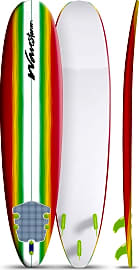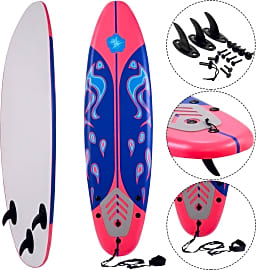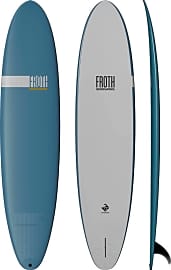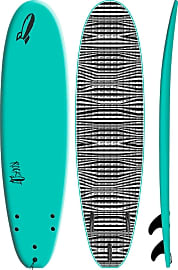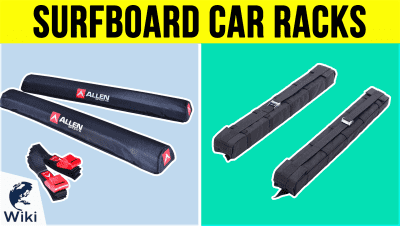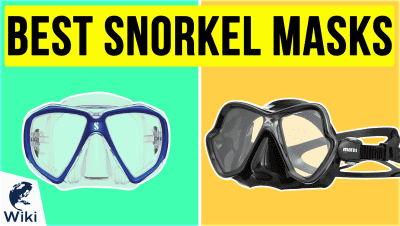The 10 Best Foam Surfboards

This wiki has been updated 38 times since it was first published in January of 2016. You, too, can learn to shred the gnar like the pros with one of these high-quality foam surfboards. Designed to be durable, forgiving and easy to control, and coming in both short and long options, they are ideal for newcomers to surfing and those looking to improve their skills, but are also suitable for anyone wanting an affordable, lightweight board to catch some waves. When users buy our independently chosen editorial selections, we may earn commissions to help fund the Wiki.
Editor's Notes
January 09, 2020:
If you're lucky enough to live in a coastal region, or if you plan on taking a vacation to the beach sometime soon, a surfboard is a great investment. They offer an intuitive way to exercise and can help build balance and coordination. Plus, surfing is just plain fun. The boards we've picked out are made primarily from foam for buoyancy, but also have stringers (bones, essentially) constructed from either fiberglass or wood. Most of the time, boards are covered with resin to allow them to better cut through the water. It's up to you to decide whether or not to wax the surface of your board.
The boards in this collection were selected with a range of users in mind. There are options that are perfect for beginners, and others that will meet the needs of experienced surfers. If you don't have much experience with waves, a bodyboard can make a great transitional tool.
The Boardworks Froth, Driftsun Nymbus, Wavestorm Classic, South Bay Board Co. Heritage, and Rock It Shortbus have been added to the list, included because of their cool designs, quality constructions, and maneuverability. Unfortunately, the California Board Company, Body Glove Soft Board, Gold Coast 7 Foot Ruccus, BIC Sport Dura-Tec, and Gold Coast 8 Foot Verve have been removed due to availability and quality concerns.
Special Honors
Olaian 500 For surfers under 175 pounds, this is an affordable and stylish option that's designed specifically for newbies. It features three soft-edge fins that mitigate the risk of injury, a built-in carry handle, and reinforced edges for durability. What more could you ask for? decathlon.com
Gnaraloo Flounder Pounder Thanks to a super-soft bottom, this one is great for folks who haven't quite got the hang of surfing just yet. It's crafted to hold its form under pressure, which is an important note if you plan on tackling those larger swells. The feel of riding this board closely approximates that of a fiberglass board. surfindustries.com
Why Get A Foam Board?
Of course, one of the most common varieties is the foam board.
In the earliest days of surfing, islanders — specifically those that inhabited ancient Hawaii — used elongated wood platforms to cruise the waves in search of spiritual, recreational, and social release. These prototypical surfboards were likely considered feats of engineering for their time, but they were heavy and followed just one or two basic designs: crafted either from Ula or Koa trees, and made long or short depending on the rider's social status.
Those first pioneers of surfing might be amazed to find how much further that piece of wood has evolved. Today, surfboards come in all manner of shapes and sizes, from long to short boards, thick to thin boards, and boards made out of rubber to those made out of high-tech fiberglass. Each type is specifically designed to deliver optimum performance under varying personal and environmental factors, whether they be wave size or an individual rider's skill level.
Of course, one of the most common varieties is the foam board. As surfing has gone from a sport practiced primarily by dedicated enthusiasts to one embraced by beach-going tourists everywhere, it's this board that has become the default introductory model for beginners and novices looking to get in on the action. Indeed, visit any rental shop or surf school and you'll more than likely be given a foam board on which to — pun intended here — learn the breaks.
That's because foam boards incorporate several specific elements that make them especially suited to beginner use. Usually made of strong polyurethane material, they're often more durable than other models, allowing them to withstand all the abuse that an inexperienced rider is likely to subject their first board to without being damaged. Many foam boards also have more volume than other types, giving them greater buoyancy for easier paddling and a smoother, more stable ride.
Then there's the cost factor: foam boards are generally and often many times more affordable than fiberglass or wood boards, making them a great entry-level choice for those who aren't ready to make a serious financial commitment to the sport.
Long Or Short? Length Matters
As previously noted, surfboards have come to express a wide variety of designs, and even within the category of foam boards there are notable differences. Some boards feature an outline that is more streamlined than others, making it easier to carve and maneuver in the water, while others are more egg-shaped, giving the rider better stability. The number of fins may also differ from one board to another, effecting its speed and control.
There's also the basic quality of the materials used in the making of the board, which, because foam boards are often mass-produced, can vary depending on the manufacturer.
There's also the basic quality of the materials used in the making of the board, which, because foam boards are often mass-produced, can vary depending on the manufacturer.
One of the most important things to consider, though, is board length. In their effort to cater to a range of users, foam boards come in many different sizes, from short, sporty lengths to long, flat ones. For the most inexperienced beginners, it's advised that they start with a longer board, as those are often both easier to paddle and to stand on while new surfers get the hang of the practice. Shorter boards are more difficult for novices to use, but they're also faster and more agile, making them a good option when you want to take your surfing skills to the next level.
Still, which length is best for you will probably come down to personal preference. Even more experienced riders sometimes prefer the comfort and leisure of a longer board, while others maintain shorter boards are just more fun. You should also keep where you like to surf in mind, as bigger boards are generally best for smaller, longer-breaking waves, and shorter boards for big hairy pipelines.
Tips For Caring For Your Board
Like any piece of sports equipment, surfboards require a certain level of maintenance in order to ensure their best performance. No matter what kind of board you have, keeping it dry and protected in between uses is essential, which means getting a carrying and storage bag should be next on your to-do list after buying the board itself.
Washing your board with fresh water after each session will help prevent its materials from degrading, as saltwater can be corrosive.
Of course, one of the greatest things about foam boards is the fact that they don't need much attention — their basic, soft construction means they won't ding or break as easily as others. That also makes them a good travel board, as you don't have to worry about banging them up as you trek to and from the beach.
Still, there are a few tips tips should follow to keep your foam board in optimal shape. Washing your board with fresh water after each session will help prevent its materials from degrading, as saltwater can be corrosive. Direct sunlight can also damage and fade the color of the board, so keeping it in the shade when not in use is also important.
Most surfboards also benefit from a good waxing before each use, which helps give the rider's feet a better grip in the water, though some foam boards come with naturally rough top surfaces for this reason. Others even feature integrated traction pads under the back foot to give the rider more control.
Finally, if you're frequently driving to the beach with your gear, you may want to consider investing in a rack for your car to keep your board safe while transporting it.


